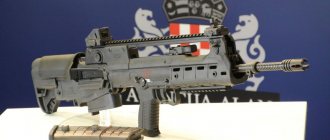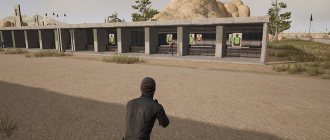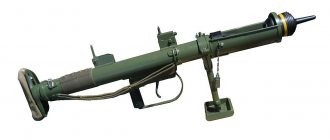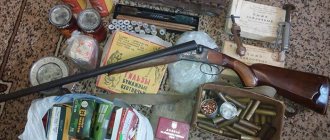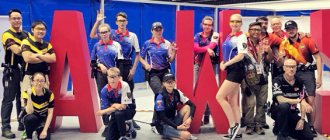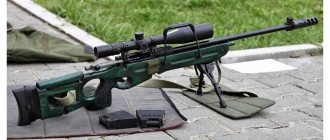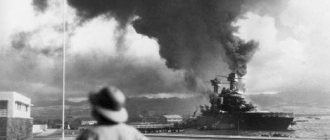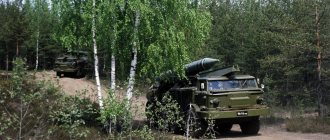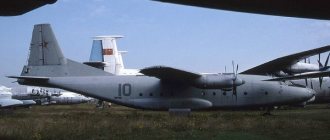| PzB M.SS.41 | |
| Type: | anti-tank rifle |
| A country: | Czechoslovakia |
| Service history | |
| Years of operation: | 1941—? |
| Used: | Waffen SS |
| Wars and conflicts: | The Second World War |
| Production history | |
| Designed by: | 1940 |
| Characteristics | |
| Weight, kg: | 13 (without ammo) |
| Length, mm: | 1360 |
| Barrel length, mm: | 1100 |
| Cartridge: | 7, 92×94 mm (Patrone 318) |
| Caliber, mm: | 7, 92 |
| Rate of fire, rounds/min: | 20 (combat) |
| Sighting range, m: | 500 |
| Type of ammunition: | box magazine 5 or 10 rounds |
| Aim: | open |
MSS-41
- an anti-tank rifle created by Czechoslovakian gunsmiths, which was in service with Germany.
An interesting feature of the MSS-41
was that it was made according to the bullpup design.
In addition, these anti-tank rifles began to be used for the first time as large-caliber sniper rifles - the troops had special teams armed with MSS-41
with optical sights, whose main task was to destroy firing points from long distances.
The latter meant machine-gun embrasures of bunkers and bunkers, sniper positions, crews of machine guns, mortars and light field artillery .
Description
A characteristic feature of this sample was that it was made according to the bullpup design - the impact mechanism and the magazine are located in the butt behind the trigger. Thanks to this arrangement, it is possible to increase the length of the barrel without increasing the overall length and weight of the weapon, which has a positive effect on range and accuracy. In all likelihood, it was thanks to the M.SS.41 that the Bullpup scheme became quite popular among small arms designers
.
During reloading, the shooter, just like in the German PzB.39, did not need to remove his hands from the pistol grip, since he manually moved the barrel back and forth using this handle. The barrel was locked by a coupling on which a pistol grip was mounted, with an assembled trigger mechanism and safety catch. This gun did not have a bolt in the usual sense. The bolt was part of a fixed butt plate and was engaged with the barrel by a coupling mounted on the barrel with a threaded fit. The clutch rotated when the pistol grip of the fire control moved forward and upward. Then, as the handle moved forward, the barrel began to move. A perforated casing served as a guide for the barrel with the coupling. During the reverse movement, the barrel rested on the cartridge, held by the ejector hook. By turning the pistol fire control handle down, the barrel was locked with the bolt. The trigger mechanism was mounted in a pistol grip, on the left side of which there was a safety lever. The sighting devices consisted of folding front sights and a sight designed for shooting at a range of 500 m. The location of the barrel, receiver and butt on the same axis, a spring shock absorber covered with rubber shoulder rest (which was also a mainspring), and in addition, the use of a single-chamber muzzle brake closed type minimized recoil when firing. The cartridges were fed from a removable box magazine with a capacity of 5 - 10 rounds. The magazines were attached to the bottom on the left side of the receiver. Practical rate of fire reached 20 rounds/min
.
This gun was more compact than the PzB.39, but its cost was higher, and in terms of armor penetration they were more or less equal - effective against light armored vehicles, but absolutely powerless against medium and heavy tanks
.
After manufacturing several thousand PzB M.SS.41
their production by Waffenwerke Brunn was discontinued
.
Links
- Maxim Popenker
anti-tank rifle PzB M.SS.41/ PzB-41(t) (Czechoslovakia - Germany) (Russian). world.guns.ru. Archived from the original on April 15, 2012. Retrieved September 11, 2010.
| ;Weapons of the Wehrmacht during World War II | |
| Pistols | Luger P-08 · Walther P38 · Walther RRK · Sauer 38H · Mauser C96 · Mauser M1914 · Mauser HSc · Mauser 1934 · Kampfpistole · Dreyse M1907 · Volkspistole |
| Rifles, machine guns, carbines | Mauser 98k Gewehr 41 FG-42 Gewehr 43/Karabiner 43 StG-44 StG45(M) Volkssturmgewehr 1-5 |
| Submachine guns | MP-18/MP-28 MP-34 MP-35 MP-36III MP-40 MP-41 EMP-35 MP3008 "Volks MP" |
| Machine guns | MG-08 MG-13 MG-34 MG-42 |
| Anti-tank weapons, mortars, flamethrowers | Faustpatron Panzerfaust Panzerschreck Pupchen (8.8 cm Raketenwerfer 43) Luftfaust Panzerbüchse 38 Flammenwerfer 35 Einstossflammenwerfer 46 Granatwerfer 36 Schwerer Granatwerfer 34 KZ 8 cm GrW 42 Granatwerfer 42 Kampfpistole 2 , 8 cm sPzB 41 |
| Foreign weapons | Pistols and revolvers : R.612(r) R.680(i) P.12(ö) P.640(b) P.642(f) Astra 400 9-mm pistole(Astra) 43 · P.35(p)/35/1(p) · P.27(t) · P.615(r) · P.660(a) · Rifles : Vz.24/G24(t) · Submachine guns : MP.34(ö) · MP.722(f) · MP.746(d) · MP.716(r) · MP.715(r) · MP.717(r) · MP.41(r) · MP.719(r) · MP.739(i) · MP.738(i) · MP.761(f) · MP.769(r) · Machine guns : MG26(t) · Schwarzlose machine gun · Anti-tank rifles : Solothurn S18 -100 · Panzerbüchse 35(p) · M.SS-41 |
| Hand grenades | Stielhandgranate Eihandgranate |
| Ammo | 7.65×17 mm 7.63×25 mm Mauser 7.92×33 mm 7.65 mm Luger 7.92×57 mm 9×19 mm Parabellum |
Anti-tank rifles PzB 38 and PzB 39
Under the terms of the Treaty of Versailles, Germany did not have the right to create new types of small arms, but could only modernize the small arms systems that were in service before the end of the First World War. Nevertheless, in 1926, engineers (not without the help of Soviet “comrades”) created the main German anti-tank weapon at the beginning of World War II - the 37 mm PAK 35/36 cannon, which was put into service in 1935. Around the same time, the need arose to equip infantry with lighter melee weapons. At the same time, the experience of combat use of the Mauser Tankgewehr M 1918 anti-tank rifle and the TUF MG 18 heavy machine gun was considered, which, however, was not considered successful, as evidenced by the rejection of a rather promising 13x92 mm caliber cartridge used in these samples.
German designers received technical specifications from the Wehrmacht command for the development of anti-tank rifles. The gun had to be operated by one person, its weight should not exceed 15 kg (for the M 1918 rifle - over 17 kg), from a distance of 100 m, a bullet fired from such a gun had to penetrate 30 mm of armor at an impact angle of 60°. Although already in 1932 it was clear that the 7.92 mm Mauser cartridge with a pointed bullet and a steel core was only partially suitable for effective anti-tank defense, the originally intended 13 mm caliber was nevertheless reduced to 7.92 mm. Soon the armor-piercing cartridge itself was developed and received the index P 318.
One of the first anti-tank rifles designed for the new cartridge was created by engineers at the beginning of 1938 and received the designation PzB 38. It weighed more than 16 kg and was equipped with a drum container with a capacity of 36 rounds - the so-called “loading accelerator”.
Read: German fighter Heinkel He 280
When firing, the armor piercer always had the next cartridge at hand, which was quite convenient. However, the dimensions and weight of this unit caused criticism, and a number of PzB 38 rifles were not equipped with a container. To support the rifle, a fairly strong and lightweight bipod from an MG 34 machine gun was installed.
Tests that took place in 1938 revealed a number of shortcomings; the PzB 38 rifle was soon modernized and, under the designation PzB 39, entered service with the Wehrmacht infantry units. As for the initial modification (PzB 38), there is information that despite the fact that the military rejected this weapon, it managed to produce about 1,600 guns, which were later used in military operations.
In the specialized literature there is an opinion that the rifle was quite capricious in operation, and the automatic ejection of the cartridge case ceased to function at the slightest contamination. In addition, the entire design was rated as expensive to manufacture.
In the summer of 1938, an experimental batch of PzB 38 rifles - the first anti-tank rifle of the Wehrmacht infantry - was transferred for military testing, after which the gun underwent major modernization. First of all, this affected the reduction in the weight of the gun to 12.6 kg. In addition, the massive and unreliable container was replaced with two clips of 10 rounds each (the clips were not magazines inserted into the rifle's chamber receiver, but were a smaller copy of the "accelerator" container). The weapon loading mechanism was also changed - in the 1938 model, the bolt opened automatically, which was convenient, but increased the cost of production. The automatic opening unit was excluded from the design.
In 1939, a new model of anti-tank rifle under the designation PzB 39 was put into mass production and put into service immediately, without military testing. By the beginning of World War II, German units had only a little more than 500 anti-tank rifles; six months later their number had doubled. According to the states in 1940, the PzB 39 was the main anti-tank defense weapon of the German infantry. The infantry division was armed with 90 units of anti-tank rifles, the motorized division - 83, and the tank division - 57. According to some data, by the time of the attack on the Soviet Union, Wehrmacht units had more than 25,000 units of PzB 38 and PzB 39.
Read: Thompson submachine guns
At the initial stage of the Second World War, the PzB 38 and PzB 39 anti-tank rifles were used quite effectively to combat light tanks, wedges and armored vehicles of English, Polish and French production. To be fair, it should be admitted that in the first campaigns the German armor-piercing soldiers did not have too much work - the enemy’s armored vehicles were dealt with mainly by aviation and artillery. Circumstances changed radically after the attack on the USSR.
A PzB 39 rifle bullet at a distance of 300 m barely penetrated 20 mm thick armor. And although it was obvious that such armor penetration was not enough, this fact was not taken into account until the autumn of 1941, when these negative circumstances clearly manifested themselves during the battle of Moscow. It turned out that both German cartridges and weapons were absolutely ineffective against Soviet tanks such as the T-34 and KV, the appearance of which on the battlefield was an extremely unpleasant surprise for the Germans. The literature even provides information that disgruntled infantrymen threw away anti-tank rifles that seemed useless to them (however, one should not unconditionally believe such stories - wartime laws were very strict towards soldiers who threw away their weapons). If the Germans threw away their rifles, the Russians picked them up and used them.
Read: German medium tank Pz.Kpfw. III
Italian veteran Eugenio Corti, who served as an officer in the artillery battalion of the Pasubio Division of the 35th Corps during World War II, describes the following incident in his memoirs (it happened in December 1942 near Stalingrad):
“...The road passed along a small bridge thrown over a beam. Below we saw a huge German tank. Abandoned. A bloody tankman's uniform lay nearby. On the side of the road near the bridge stood a German anti-tank rifle, staring at the tank with its menacing muzzle. No one was visible near him. Apparently the Russians used it to knock out a tank.”
Interestingly, in the second half of 1941, an attempt was made in the USSR to put the PzB 39 gun into mass production as a temporary measure. However, design flaws and low armor penetration were identified in the prototypes manufactured in September 1941, as a result of which work in this direction was stopped.
In total, until the beginning of 1942, 29,290 rifles of this type were produced from Germany and “Steyr” from Austria, after which production was curtailed. The rifles were still used in the Wehrmacht for almost a year, so the production of P 318 cartridges was curtailed only in August of the same year; in total, about 9.5 million cartridges were delivered to the front.
You might be interested:
- Anti-tank rifle "Mauser Tankgewehr" M 1918
- Large-caliber rifles "Steyr"
- Anti-tank rifle grenade launchers (Germany)
- Rifle "Mauser 98"
- Automatic rifles FN FAL, FN CAL and FNC
- "Mauser Tankgever" - the first anti-tank rifle
Subscribe to
our channel in Yandex.Zen
